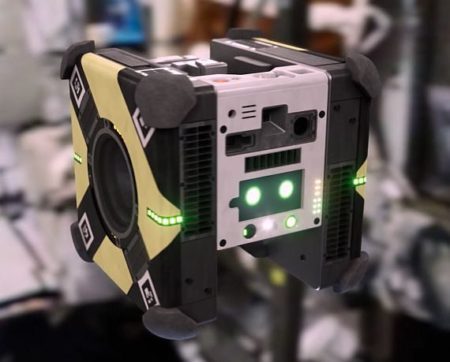May 4, 2019 – Three free-flying robots, named Honey, Queen, and Bumble, will soon represent the latest new occupants of the International Space Station (ISS). Known as Astrobees these cube-shaped robots measuring 30 centimeters (12 inches) wide, are part of the payload just launched by SpaceX to resupply ISS. Once deployed on board they will function through remote control or autonomously to help with space station maintenance, inventory tracking, and experiments. They are designed as well to serve as research platforms for conducting experiments in microgravity that demonstrate the usefulness of robots to their human space companions.
The Astrobee mode of locomotion is enabled by three technologies:
- an electric fan built into the chassis for generalized maneuvering.
- 12-variable thrust nozzles to provide instantaneous directional movement.
- a robotic gripper that is capable of grasping nearby objects including ISS handrails used by the astronauts.
The Astrobees use six onboard cameras to navigate with each serving a different purpose:
- Cellphone class high-definition camera
- HazCam
- DockCam
- PerchCam
- SciCam
- SpeedCam
The Astrobees will replace an older generation of robots, the SPHEREs that have served on the ISS for more than a decade.
Each Astrobee is modular and can be refitted with upgrades or guest payload modules to enhance performance or conduct new research initiatives. Should it run into someone or something it is equipped with corner bumpers, and accompanying signal lights. And if the lights go out, each Astrobee has its own onboard flashlight. Other features include a laser pointer, a touchscreen, speakers and a microphone.
When an Astrobee detects low battery there is a docking station for recharging on ISS residing in the Japanese Experiment Module.
Equipped with three multi-processors, two running Linux, and one Android, the Astrobees’ communications allow for downlinks through hard-wired Ethernet (connection is via the docking station) or WiFi, or a direct to the ground downlink by KU-band, a microwave spectrum commonly used for satellite communication.
The Astrobees can stream video as well as send and receive data from ISS or through a ground uplink.
Two plug-in boards are swappable for onboard crews to replace or upgrade as needed.
NASA has also ensured that telemetry to and from the Astrobees can be commanded and observed by multiple ground stations.
And unlike the SPHEREs, Honey, Queen, and Bumble can work together to accomplish tasks.
















